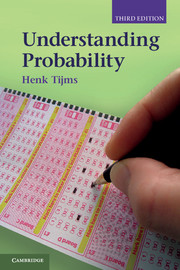Book contents
- Frontmatter
- Contents
- Preface
- Introduction
- PART ONE PROBABILITY IN ACTION
- 1 Probability questions
- 2 Law of large numbers and simulation
- 3 Probabilities in everyday life
- 4 Rare events and lotteries
- 5 Probability and statistics
- 6 Chance trees and Bayes' rule
- PART TWO ESSENTIALS OF PROBABILITY
- Appendix: Counting methods and ex
- Recommended reading
- Answers to odd-numbered problems
- Bibliography
- Index
2 - Law of large numbers and simulation
Published online by Cambridge University Press: 05 August 2012
- Frontmatter
- Contents
- Preface
- Introduction
- PART ONE PROBABILITY IN ACTION
- 1 Probability questions
- 2 Law of large numbers and simulation
- 3 Probabilities in everyday life
- 4 Rare events and lotteries
- 5 Probability and statistics
- 6 Chance trees and Bayes' rule
- PART TWO ESSENTIALS OF PROBABILITY
- Appendix: Counting methods and ex
- Recommended reading
- Answers to odd-numbered problems
- Bibliography
- Index
Summary
In the midst of a coin-tossing game, after seeing a long run of tails, we are often tempted to think that the chances that the next toss will be heads must be getting larger. Or, if we have rolled a dice many times without seeing a six, we are sure that finally we will roll a six. These notions are known as the gambler's fallacy. Of course, it is a mistake to think that the previous tosses will influence the outcome of the next toss: a coin or die has no memory. With each new toss, each of the possible outcomes remains equally likely. Irregular patterns of heads and tails are even characteristic of tosses with a fair coin. Unexpectedly long runs of heads or tails can already occur with a relatively few number of tosses. To see five or six heads in a row in 20 tosses is not exceptional. It is the case, however, that as the number of tosses increases, the fractions of heads and tails should be about equal, but that is guaranteed only in the long run. In the theory of probability, this fact is known as the law of large numbers. Just as the name implies, this law only says something about the game after a large number of tosses. This law does not imply that the absolute difference between the numbers of heads and tails should oscillate close to zero.
- Type
- Chapter
- Information
- Understanding Probability , pp. 18 - 74Publisher: Cambridge University PressPrint publication year: 2012



